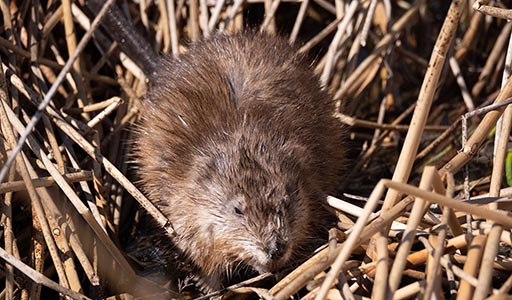Muskrats

Muskrat Information
Often mistaken for beavers, muskrats are found in bodies of water and are vital to the ecosystems of natural water sources. Muskrats feed on the wetland creatures that take up space from waterbirds and cattails, making them very important to the wildlife balance in these areas. However, when found near man-made bodies of water, they can be very pesky burrowers, and that can be reason enough to look into muskrat control services. They often burrow around at night, feeding on water plants as much as they can. Their digging can ruin close by infrastructures and cause countless additional hazards.

What does a Muskrat look like?
Muskrats are large rodents with thick, shiny fur that ranges in color from reddish brown to dark brown. They are strong swimmers, with webbed feet and scaly tails that act like rudders. The pests can grow up to two feet long and weigh up to four pounds. They are often mistaken for beavers, though their tails are longer and skinnier.

What does a Muskrat eat?
Water plants such as cattails, rushes, sedges, and pondweeds are muskrats’ main food source. However, they’ll also eat crayfish, frogs, snails, and fish. Their feeding is vital to wetland ecosystems since it opens up nesting places for water birds and controls the spread of cattails.

Muskrat habitats
Muskrats prefer habitats with lots of plant life and a nearby water source. Although they naturally live in marshes, they can also thrive along ponds, lakes, rivers, streams, drainage channels, and canals. Much like beavers, muskrats build dome-shaped nests called lodges out of leaves, stems, and mud. Lodges can be up to eight feet wide and five feet high.
Frequently Asked Questions
Muskrats and beavers are large, aquatic rodents that can easily be mistaken for each other. In order to properly identify them, check for these characteristics:
- Size – Beavers are large, weighing up to 60 pounds, while muskrats tend to reach around 4 pounds.
- Tail Shape – Muskrats have skinny, rat-like tails. Beaver tails are wide and paddle-shaped.
- Feet – Both pests have webbing between their toes, but these webs are thinner and less noticeable on muskrat paws.
As semi-aquatic rodents, muskrats and nutria share a lot of the same features. That being said, each pest has a unique appearance, and being able to tell one from the other is key to controlling infestations.
Muskrats are smaller than nutria at about 16 to 25 inches in length. These small, four-pound rodents are also distinct from nutria thanks to their:
- Long, nearly hairless tails, which are flattened vertically
- Small forepaws and webbed hind feet
- Dense, grayish-brown fur protected by coarse guard hairs
Nutria are most often mistaken for beavers rather than muskrats due to their larger size. The rodents reach about two feet long and can weigh up to 20 pounds. Nutria also have:
- Rounded, hairy tails that are pointed near the end
- Hind legs noticeably longer than their front legs
- Large, visible incisors that are yellow to orange in color


